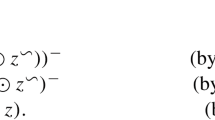Abstract
Recently, a special algebra called EQ-algebra (we call it here commutative EQ-algebra since its multiplication is assumed to be commutative) has been introduced by Novák (Proceedings of the Czech-Japan seminar, ninth meeting, Kitakyushu and Nagasaki, 18–22 August, 2006), which aims at becoming the algebra of truth values for fuzzy type theory. Its implication and multiplication are no more closely tied by the adjunction and so, this algebra generalizes commutative residuated lattice. One of the outcomes is the possibility to relax the commutativity of the multiplication. This has been elaborated by El-Zekey et al. (Fuzzy Sets Syst 2009, submitted). We continue in this paper the study of EQ-algebras (i.e., those with multiplication not necessarily commutative). We introduce prelinear EQ-algebras, in which the join-semilattice structure is not assumed. We show that every prelinear and good EQ-algebra is a lattice EQ-algebra. Moreover, the \(\{\wedge,\vee,\rightarrow,1\}\)-reduct of a prelinear and separated lattice EQ-algebra inherits several lattice-related properties from product of linearly ordered and separated EQ-algebras. We show that prelinearity alone does not characterize the representable class of all good (commutative) EQ-algebras. One of the main results of this paper is to characterize the representable good EQ-algebras. This is mainly based on the fact that \(\{\rightarrow,1\}\)-reducts of good EQ-algebras are BCK-algebras and run on lines of van Alten’s (J Algebra 247:672–691, 2002) characterization of representable integral residuated lattices. We also supply a number of potentially useful results, leading to this characterization.

Similar content being viewed by others
Notes
Given an algebra \(\left\langle E,F\right\rangle ,\) where F is the set of operations on E, and \(F'\subseteq F.\) Then the algebra \(\left\langle E, F'\right\rangle \) is called the F′-reduct of \(\left\langle E,F\right\rangle .\) The subalgebras of \(\left\langle E,F'\right\rangle \) are then referred to as F′-subreducts of \(\left\langle E,F\right\rangle .\)
This approach is well known in literature, see, e.g., Abdel-Hamid and Morsi (2007) where the authors established a representation theorem of prelinear residuated algebras, in which the lattice structure is not assumed.
References
Abdel-Hamid A, Morsi N (2007) Representation of prelinear residuated algebras. Int J Comput Cogn 5(4):13–20
Blount K, Tsinakis C (2003) The structure of residuated lattices. Int J Algebra Comput 13:437–461
Blyth T (2005) Lattices and ordered algebraic structures. Springer, London
Bodenhofer U (2000) A similarity-based generalization of fuzzy orderings preserving the classical axioms. Int J Uncertain Fuzziness Knowl Based Syst 8:593–610
Burris S, Sankappanavar H (1981) A course in universal algebra. Graduate texts in mathematics, vol 78. Springer, Berlin
Castañeda H (1976) Leibniz’s syllogistico-propositional calculus. Notre Dame J Formal Log XVII(4):338–384
El-Zekey M, Novák V, Mesiar R (2009) Semicopula-based EQ-algebras. Fuzzy Sets Syst (submitted)
Esteva F, Godo L (2001) Monoidal t-norm based logic: towards a logic for left-continuous t-norms. Fuzzy Sets Syst 124:271–288
Esteva F, Godo L, Hájek P, Montagna F (2003) Hoops and fuzzy logic. J Log Comput 13:531–555
Fleischer I (1987) Subdirect products of totally ordered BCK-algebras. J Algebra 111:384–387
Fleischer I (1988) Every BCK-algebras is a set of residuables in an integral pomonoid. J Algebra 119:360–365
Gispert J, Torrens A (2007) Bounded BCK-algebras and their generated variety. Math Log Q 53:206–213
Gracía Olmedo F, Rodríguez Salas A (2000) Linearization of the BCK-logic. Stud Log 65:31–51
Gratzer G (1979) Universal algebras. Springer, Berlin
Hájek P (1998) Metamathematics of fuzzy logic. Kluwer, Dordrecht
Hájek P (2003) Fuzzy logics with noncommutative conjuctions. J Log Comput 13:469–479
Höhle U (1995) Commutative residuated l-monoids. In: Höhle U, Klement EP (eds) Non-classical logics and their applications to fuzzy subsets. A handbook of the mathematical foundations of fuzzy set theory. Kluwer, Dordrecht, pp 53–106
Iseki K (1978) An introduction of the theory of BCK-algebras. Math Jpn 23:1–26
Noguera, Esteva F, Gispert J (2005) On some varieties of MTL-algebras. Log J IGPL 13:443–466
Novák V (2005) On fuzzy type theory. Fuzzy Sets Syst 149:235–273
Novák V (2006) EQ-algebras: primary concepts and properties. In: Proceedings of the Czech-Japan seminar, ninth meeting, Kitakyushu and Nagasaki, 18–22 August 2006, Graduate School of Information, Waseda University, pp 219–223
Novák V, de Baets B (2009) EQ-algebras. Fuzzy Sets Syst (to appear)
Novák V, Dyba M (2009) Non-commutative EQ-logics and their extensions. In: Proceedings of the world congress IFSA-EUSFLAT 2009, University of Málaga, Lisbon, Portugal
Ono H, Komori Y (1985) Logics without the contradiction rule. J Symb Log 50:169–201
Pałasinski M (1980) Some remarks on BCK-algebras. Math Semin Notes Kobe Univ 8:137–144
Pałasinski M (1981) On ideal and congruence lattices of BCK-algebras. Math Jpn 26:543–544
Pałasinski M (1982) An embedding theorem for BCK-algebras. Math Semin Notes Kobe Univ 10:749–751
Raftery JG (1987) On prime ideals and subdirect decompositions of BCK-algebras. Math Jpn 32:811–818
van Alten C (2002) Representable biresiduated lattices. J Algebra 247:672–691
Acknowledgments
I would like to thank to Vilem Novák for the repeated reading of the drafts of this paper and helping me to improve it a lot in many aspects. Thanks are also due to the grant obtained from SAIA under the National Scholarship Program (NSP) of the Slovak Republic, and the Department of Mathematics and Descriptive Geometry at Slovak University of Technology at Bratislava, which provided excellent facilities for the duration of this research.
Author information
Authors and Affiliations
Corresponding author
Rights and permissions
About this article
Cite this article
El-Zekey, M. Representable good EQ-algebras. Soft Comput 14, 1011–1023 (2010). https://doi.org/10.1007/s00500-009-0491-4
Published:
Issue Date:
DOI: https://doi.org/10.1007/s00500-009-0491-4




